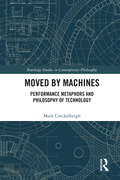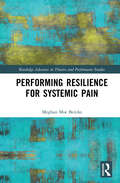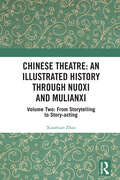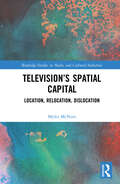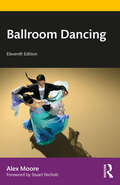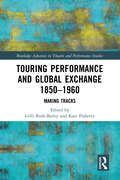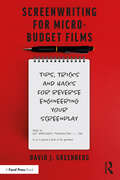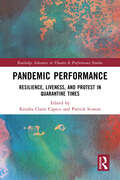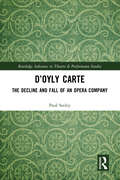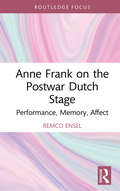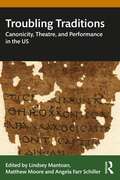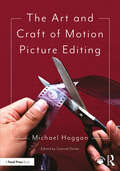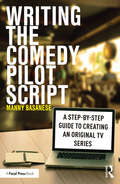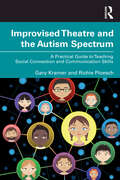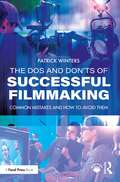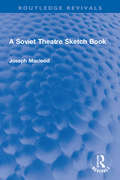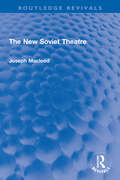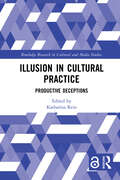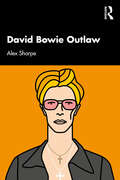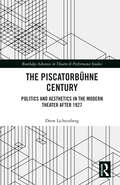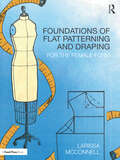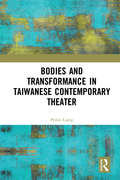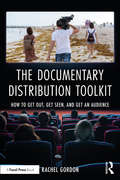- Table View
- List View
Moved by Machines: Performance Metaphors and Philosophy of Technology (Routledge Studies in Contemporary Philosophy)
by Mark CoeckelberghGiven the rapid development of new technologies such as smart devices, robots, and artificial intelligence and their impact on the lives of people and on society, it is important and urgent to construct conceptual frameworks that help us to understand and evaluate them. Benefiting from tendencies towards a performative turn in the humanities and social sciences, drawing on thinking about the performing arts, and responding to gaps in contemporary artefact-oriented philosophy of technology, this book moves thinking about technology forward by using performance as a metaphor to understand and evaluate what we do with technology and what technology does with us. Focusing on the themes of knowledge/experience, agency, and power, and discussing some pertinent ethical issues such as deception, the narrative of the book moves through a number of performance practices: dance, theatre, music, stage magic, and (perhaps surprisingly) philosophy. These are used as sources for metaphors to think about technology—in particular contemporary devices and machines—and as interfaces to bring in various theories that are not usually employed in philosophy of technology. The result is a sequence of gestures and movements towards a performance-oriented conceptual framework for a thinking about technology which, liberated from the static, vision-centred, and dualistic metaphors offered by traditional philosophy, can do more justice to the phenomenology of our daily embodied, social, kinetic, temporal, and narrative performances with technology, our technoperformances. This book will appeal to scholars of philosophy of technology and performance studies who are interested in reconceptualizing the roles and impact of modern technology.
Performing Resilience for Systemic Pain (Routledge Advances in Theatre & Performance Studies)
by Meghan Moe BeitiksHow might performance serve as a means for facing ubiquitous trauma and pain, in humans and ecologies? While reflecting on her multidisciplinary work Systems of Pain/Networks of Resilience, artist Meghan Moe Beitiks considers bodies of knowledge in Trauma Theory, Intersectional Feminist Philosophy, Ecology, Disability Studies, New Materialism, Object-Oriented Ontology, Gender Studies, Artistic Research, Psychology, Performance Studies, Social Justice, Performance Philosophy, Performance Art, and a series of first-person interviews in an attempt to answer that question. Beitiks brings us through the first-person process of making the work and the real-life, embodied encounters with the theories explored within it as an expansion of the work itself. Facing down difficult issues like trauma, discrimination, and the vulnerability of the body, Beitiks looks to commonalities across species and disciplines as means of developing resilience and cultivating communities. Rather than paint a picture of glorious potential utopias, Beitiks takes a hard look at herself as an embodiment of the values explored in the work, and stays with the difficult, sucky, troubling, work to be done. Performing Resilience for Systemic Pain is a vulnerable book about the quiet presence and hard looking needed to shift systems away from their oppressive, destructive realities.
Chinese Theatre: Volume Two: From Storytelling to Story-acting
by Xiaohuan ZhaoChinese Theatre: An Illustrated History Through Nuoxi and Mulianxi is the first book in any language entirely devoted to a historical inquiry into Chinese theatre through Nuoxi and Mulianxi, the two most representative and predominant forms of Chinese temple theatre. Volume Two is a continuation of the historical inquiry into Chinese theatre with focus shifted from Mulian storytelling to Mulian story-acting. Thus, this volume traces the historical trajectory of xiqu from Northern dramas to Southern dramas and from elite court theatre to mass regional theatre with pivotal forms and functions of Mulianxi examined, explicated and illustrated in association with the development of corresponding genres of xiqu. In so doing, every aspect of Mulianxi is considered not in the margins of xiqu but in and of itself. While this volume is primarily concerned with Mulianxi, references are also made to other forms of Chinese performing arts and temple theatre, Nuoxi in particular, as Mulianxi has been performed since the twelfth century as, or in company with, Nuoxi, to cleanse the community of evil spirits and epidemic diseases. This is an interdisciplinary book project that is aimed to help researchers and students of theatre history understand the ritual origins of Chinese theatre and the dynamic relationships among myth, ritual, religion and theatre.
Television’s Spatial Capital: Location, Relocation, Dislocation (Routledge Studies in Media and Cultural Industries)
by Myles McNuttThis book launches a comprehensive detailing of the dramatic expansion of the geography of television production into new cities, states, provinces, and countries, and how those responsible for shaping the "landscape" of television have been forced to adapt, taking established strategies for engaging with space and place through mediated representation and renegotiating them to account for the new map of television production. Modeling media studies research that considers the intersection of production, textuality, distribution, and reception, Myles McNutt identifies how the expansion of where television is produced has intersected with the kinds of places represented on television, and how shifts in the production, distribution, and consumption of television content have shifted the burden of representing cities and countries both locally and internationally. Through a combination of industry interviews, textual analysis, and in-depth consideration of industry and audience discourse, the book argues that where television takes place matters more today than it ever has, but that the current system of spatial capital remains constrained by traditional industry logics that limit the depth of engagement with place identity even as the expectation of authenticity grows significantly. Representing a cross section of media industry studies, television studies, and cultural geography, this book will appeal to scholars and students within multiple areas of media studies, including production studies and audience studies, in addition to television studies broadly.
Ballroom Dancing
by Alex MooreNow in its eleventh edition, this classic and comprehensive handbook has been revised to bring it up to date with changes on the dance floor and in the rules of dance competitions. The Quickstep, Waltz, Foxtrot, and Tango are all illustrated and described in great detail, as well as the versions of most dances approved for championships. Diagrams demonstrate every step from both the Leader’s and Follower’s perspectives, and a collection of photographs new to this edition celebrate the diverse range of dancers involved with ballroom. This is the go-to book for dancers, competition judges, teachers, and anyone who needs to be at the forefront of today’s ballroom technique, from amateur practice to international championships.
Ballroom Dancing
by Alex MooreNow in its eleventh edition, this classic and comprehensive handbook has been revised to bring it up to date with changes on the dance floor and in the rules of dance competitions.The Quickstep, Waltz, Foxtrot, and Tango are all illustrated and described in great detail, as well as the versions of most dances approved for championships. Diagrams demonstrate every step from both the Leader’s and Follower’s perspectives, and a collection of photographs new to this edition celebrate the diverse range of dancers involved with ballroom.This is the go-to book for dancers, competition judges, teachers, and anyone who needs to be at the forefront of today’s ballroom technique, from amateur practice to international championships.
Make Toons That Sell Without Selling Out: 10th Anniversary Edition
by Bill Plympton"The King of Independent Animation" has returned with this 10th anniversary edition of Make Toons That Sell Without Selling Out. Delve into the secrets behind creating poignant indie animation without compromising or sacrificing your own ideals and visions. World-renowned animator, author, and Academy Award-nominated Bill Plympton will help guide you in how to make a career in animation. With time-saving techniques, secrets on crafting a good narrative, and more, Plympton will teach you how to breathe life into your own animated films. By studying and deconstructing his lessons from his own works and styles, you too will be able to carve out a career in animation without betraying yourself.
Touring Performance and Global Exchange 1850-1960: Making Tracks (Routledge Advances in Theatre & Performance Studies)
by Gilli Bush-BaileyThis collection uncovers connections and coincidences that challenge the old stories of pioneering performers who crossed the Atlantic and Pacific oceans from the mid-nineteenth to the mid-twentieth century. This book investigates songlines, drama, opera, music theatre, dance, and circus—removing traditional boundaries that separate studies of performance, and celebrating difference and transformation in style, intention, and delivery. Well known, or not known at all, travelling performers faced dangers at sea and hazardous journeys across land. Their tracks, made in pursuit of fortune and fame, intersected with those made by earlier storytellers in search for food. Making Tracks takes a fresh look at such tracks—the material remains—demonstrating that moving performance does far more than transfer repertoires and people; it transforms them. Touring performance has too often been conceived in diasporic terms, as a fixed product radiating out from a cultural centre. This collection maps different patterns—ones that comprise reversed flows, cross currents, and continually proliferating centres of meaning in complex networks of global exchange. This collection will be of great interest to scholars and students in theatre, music, drama studies and cultural history.
Screenwriting for Micro-Budget Films: Tips, Tricks and Hacks for Reverse Engineering Your Screenplay
by David J GreenbergScreenwriting for micro-budget films can present its own challenges and this book takes the reader through all the considerations that need to be made to write an effective screenplay for a low-budget film. Drawing on his own experience, case studies from films such as Primer, Coherence and Reservoir Dogs, as well as the perspectives of working screenwriters such as Joe Swanberg and Alex Ross-Perry, Greenberg explores common pitfalls screenwriters face and suggests practical solutions. This book lays the groundworks of the realities of low-budget filmmaking and also talks through the practical aspects, such as story structure and genre considerations. Greenberg makes the process of writing a screenplay for a low-budget film accessible and creative, allowing student and independent filmmakers to tailor their writing for their films. This book is ideal for aspiring screenwriters, independent filmmakers and students of screenwriting.
Pandemic Performance: Resilience, Liveness, and Protest in Quarantine Times (Routledge Advances in Theatre & Performance Studies)
by Kendra Claire CapecePandemic Performance chronicles the many ways that people are surviving/thriving through performance in a global pandemic. Covering artists and events from across the United States: from New York to California and from South Dakota to Texas, the chapters are equal parts theory and practice, weaving scholarship with personal experience from contributors who are interdisciplinary artists, scholars, journalists, and community organizers providing unique and invaluable perspectives on the complicated work of resilience during COVID-19. This study will hold interest for students and scholars in the performing arts, arts, and social justice as well as professional artmakers and creative community organizers.
D’Oyly Carte: The Decline and Fall of an Opera Company (Routledge Advances in Theatre & Performance Studies)
by Paul SeeleyThis book considers and discusses aspects of the management of the D’Oyly Carte Opera Company in the twentieth century since the death of its founder Richard D’Oyly Carte, and concentrates on key events that contributed to its demise in 1982. In this book, Paul Seeley follows the analytical model that proposes no single factor triggered the collapse, but rather several, both external and internal. In the case of an opera company the external factors may include public taste and market forces, but more significant are the internal factors such as the management decisions taken in response to external factors and how these compare with the original artistic aims, aspirations and business models of the founder. This is a study by someone with close observation of the administration; at the 1982 demise, Seeley was assistant to the company manager, having earlier served on the music staff. The book is a must-read for music historians, theatre historians and arts-management professionals; as an uncompromisingly critical history of the D'Oyly Carte Opera Company it is designed to serve a wider public, not just the Gilbert and Sullivan opera specialist, but anyone keen to debate the desirability of private or public sponsorship of the performing arts.
Anne Frank on the Postwar Dutch Stage: Performance, Memory, Affect (Routledge Advances in Theatre & Performance Studies)
by Remco EnselThis book is a case study into the affective history of Holocaust drama offering a new perspective on the impact of The Diary of Anne Frank, the pivotal 1950s play that was a turning point in Holocaust consciousness. Despite its overwhelming success, criticism of the Broadway makeover has been harsh, suggesting that the alleged Americanization would not do justice to the violence of the Holocaust or Anne Frank’s budding Jewishness. This study revisits these issues by focusing on the play’s European appropriation delving into the emotional intensity with which the play was produced and received. The core of the exploration is a history of the Dutch staging in ethnographic detail, based on unique archival material such as correspondence with Otto Frank, prompt books, original tapes, blueprints of the set and oral history. The microhistory of the first Dutch performance of the stage adaptation of Anne Frank’s diary examines the staging in the context of the postwar hesitant development of publicly voiced Holocaust consciousness. Influenced by memory studies and affect theory, the emphasis is on the emotional impact of the drama on both the members of the cast and the audience and will be of great interest to students and scholars in theater and performance studies, memory studies, cultural history, Jewish studies, Holocaust studies and contemporary European history.
Troubling Traditions: Canonicity, Theatre, and Performance in the US
by Lindsey MantoanTroubling Traditions takes up a 21st century, field-specific conversation between scholars, educators, and artists from varying generational, geographical, and identity positions that speak to the wide array of debates around dramatic canons. Unlike Literature and other fields in the humanities, Theatre and Performance Studies has not yet fully grappled with the problems of its canon. Troubling Traditions stages that conversation in relation to the canon in the United States. It investigates the possibilities for multiplying canons, methodologies for challenging canon formation, and the role of adaptation and practice in rethinking the field’s relation to established texts. The conversations put forward by this book on the canon interrogate the field’s fundamental values, and ask how to expand the voices, forms, and bodies that constitute this discipline. This is a vital text for anyone considering the role, construction, and impact of canons in the US and beyond.
The Art and Craft of Motion Picture Editing
by Michael HogganThis book explains the broader context of what the art and craft of motion picture editing entails, framing the creative acts of editing within an overall view of the production process and requirements for effective storytelling. This book offers real experiences and advice from seasoned editors on the editing process, providing a detailed examination of filmmaking from the editor’s point of view and exploring how best to cultivate creative relationships with other areas of production to form the final personality of the film. Emphasizing both practicality and creativity, industry veteran Michael Hoggan successfully bridges the gap between the mechanical skills of editing and the thought process behind these decisions. While most books focus primarily on the mind of the creator, this book explores the evolution of practices in film production and editing with respect to the ever-changing expectations of the audience. As the book demonstrates, understanding editing from the audience’s perspective is essential to any successful film. This book will be of interest to post-production students, independent filmmakers, film critics, and agents with editing clients. It is accompanied by a collection of rich digital materials, including a glossary, bibliography, and more.
Writing the Comedy Pilot Script: A Step-by-Step Guide to Creating an Original TV Series
by Manny BasaneseNavigating through the challenging process of writing a comedy pilot, this book will help screenwriters to create an original script for television. Practical and accessible, the book presents a step-by-step guide focusing on the key elements of the process. Incorporating both the history of TV comedy as well as its current evolving state in this age of the dramedy and an ever-increasing variety of broadcast and streaming platforms, the book will serve as a guide for the fledgling sitcom scribe. Author Manny Basanese breaks down the comedy pilot writing process from what may be perceived as an overwhelming, time-consuming mission into a series of much more manageable, smaller steps (from logline to outline to 1st, 2nd and polished draft). Utilizing his experience in Hollywood’s sitcom trenches, the author offers real-world advice on such topics as building the comedy pilot "world," creating memorable comic characters, sound sitcom structure, and the importance of crafting an emotional through line in a comedy pilot. Finally, there is also practical career guidance for marketing this just-completed script and breaking into the industry with advice on various topics such as the value of networking as well as gaining representation in the competitive Hollywood jungle. It is ideal for students of screenwriting and aspiring comedy screenwriters.
Improvised Theatre and the Autism Spectrum: A Practical Guide to Teaching Social Connection and Communication Skills
by Gary Kramer Richie PloeschThis guide provides educators, professionals, and parents with an easy-to-follow and comprehensive approach to utilizing improvised theatre as a tool to teach social and communication skills to individuals on the autism spectrum. Opening with the philosophy of the curriculum and the considerations of mental health, play, and environmental factors on individuals with autism, the book then breaks down specific activities, suggests course sequencing, and explains how each activity works and applies to desired outcomes. Packed with dozens of activities and explanations, the book includes all the information necessary to design a full curriculum or create an at-home learning program for parents. By combining the fun and engaging atmosphere of improvisational theatre with the systematic teaching of social skills, professionals and parents can cultivate learning in a way that keeps students engaged while providing long-lasting improvements in social interaction, self-confidence, and communication.
The Dos and Don'ts of Successful Filmmaking: Common Mistakes and How to Avoid Them
by Patrick WintersMistakes are easy to make, but often difficult to undo. The greater the knowledge and experience a filmmaker has, the fewer mistakes are made by them. This introductory-level guide to filmmaking teaches effective preproduction, production and postproduction with a focus on many of the common mistakes made and how to avoid them. Filled with practical advice and information on the process of successfully making a film, Patrick Winters guides you through the whole process from preproduction to postproduction, teaching how to plan a shoot, accomplish that shoot and then follow the steps needed to edit and mix your film, highlighting key considerations and potential pitfalls to avoid along the way. The book covers everything from getting your story production ready, securing funding and budgeting appropriately, casting actors, assigning crew members, developing production design, shooting efficiently and effectively, technical and aesthetic camera and lighting choices, sound considerations, picture and sound editing and mixing, to the final stages of distribution and exhibition. Drawing on Winters' years of filmmaking and teaching experience, this book provides you with all the technical and aesthetic knowledge required to make a film, highlights common mistakes to avoid, and explains where to put your time and money into where it shows, resulting in a successfully made film that will stand out from the crowd. A combination of what to do and what not to do, this is ideal for introductory-level filmmaking students, as well as independents just starting out.The online support material includes deal memo templates, walkie-talkie lingo, camera and sound reports, first AD roll call, distribution and exhibition and additional information on booming.
A Soviet Theatre Sketch Book (Routledge Revivals)
by Joseph MacleodFirst Published in 1951, A Soviet Theatre Sketch Book presents Joseph Macleod’s take on Russian Theatre in a semi-fictional way to show the effect of the productions upon different audiences. By using his pen as an artist uses his pencil, he gives, for the first time, an account of theatre audiences as composed of individual human beings and is able to paint the scenes vividly without neglecting the technical methods of the Soviet stage. By supple use of the sketch- book form, theatres, theatre-schools, actors, and actresses including some no longer appearing are painted into an all-over view of Russian and Ukrainian post-war life. In this book the author writes less immediately about the Soviet Union and does not depend on topicality or stop press news. Joseph Macleod and his wife visited the Soviet Union as the guests of the Russian and Ukrainian Societies for Cultural Relations with Foreign Countries. This book will be of interest to scholars and researchers of theatre, history of theatre, and performance studies.
The New Soviet Theatre (Routledge Revivals)
by Joseph MacleodFirst Published in 1943, The New Soviet Theatre presents Joseph Macleod’s take on the development and rapid changes in the Soviet Theatre since late 1930s. Through scattered articles and reports, books and bulletins, and his own visits to the USSR, Macleod showcases what we know as ‘Socialist Realism’. He brings themes like the shortcomings of the old theatre; the audience beyond the Caucasus; new socialist audiences; Alexey Popov of the Central Theatre of the Red Army; new writers and new plays; and popularity of Shakespeare both in the central theatres and in remoter and unexpected places. Written graphically but founded on scholarship this book will be an essential read for scholars and researchers of history of theatre, European theatre, theatre and performance studies.
Illusion in Cultural Practice: Productive Deceptions (Routledge Research in Cultural and Media Studies)
by Katharina ReinThis volume explores illusionism as a much larger phenomenon than optical illusion, magic shows, or special effects, as a vital part of how we perceive, process, and shape the world in which we live. Considering different cultural practices characterized by illusionism, this book suggests a new approach to illusion via media theory. Each of the chapters analyses a specific kind of illusionistic practice and the concept of illusionism it entails in a given context, including philosophy, perception and cognitive theory, performance magic, occultism, optics, physiology, early cinema, cartomancy, spiritualism, architecture, shamanic rituals, and theoretical physics, to show the diversity of shapes that illusionism and illusions can take. The book provides detailed analyses of illusions within performance and ritual magic, philosophy, art history and psychology as well as a first approach to the study of illusions outside of these established fields. It aims to find ways of identifying and analysing a wider range of illusions in the humanities. This multidisciplinary and comprehensive volume will appeal to scholars and students with an interest in media and culture, theatre and performance, philosophy, sociology, politics and religion. This publication was supported by the Internationales Kolleg für Kulturtechnikforschung und Medienphilosophie of the Bauhaus-Universität Weimar with funds from the German Federal Ministry of Education and Research. IKKM Books Volume 47An overview of the whole series can be found atwww.ikkm-weimar.de/schriften
David Bowie Outlaw: Essays on Difference, Authenticity, Ethics, Art & Love
by Alex SharpeThis book explores the relevance of David Bowie’s life and music for contemporary legal and cultural theory. Focusing on the artist and artworks of David Bowie, this book brings to life, in essay form, particular theoretical ideas, creative methodologies and ethical debates that have contemporary relevance within the fields of law, social theory, ethics and art. What unites the essays presented here is that they all point to a beyond law: to the fact that law is not enough, or to be more precise, too much, too much to bear. For those who, like Bowie, see art, creativity and love as what ought to be the central organising principles of life, law will not do. In the face of its certainties, its rigidities, and its conceits, these essays, through Bowie, call forth the monster who laughs at the law, celebrate inauthenticity as a deeper truth, explore the ethical limits of art, cut up the laws of writing and embrace that which is most antithetical to law, love. This original engagement with the limits of law will appeal to those working in legal theory, ethics and law and popular culture, as well as in art and cultural studies.
The Piscatorbühne Century: Politics and Aesthetics in the Modern Theater After 1927 (Routledge Advances in Theatre & Performance Studies)
by Drew LichtenbergThis study of the Piscatorbühne season of 1927–1928 uncovers a vital, previously neglected current of radical experiment in modern theater, a ghost in the machine of contemporary performance practices. A handful of theater seasons changed the course of 20th- and 21st-century theatre. But only the Piscatorbühne of 1927–1928 went bankrupt in less than a year. This exploration tells the story of that collapse, how it predicted the wider collapse of the late Weimar Republic, and how it relates to our own era of political polarization and economic instability. As a wider examination of Piscator’s contributions to dramaturgical and aesthetic form, The Piscatorbühne Century makes a powerful and timely case for the renewed significance of the broader epic theater tradition. Drawing on a rich archive of interwar materials, Drew Lichtenberg reconstructs this germinal nexus of theory and praxis for the modern theatre. This book will be of great interest to students and scholars in theatre, performance, art, and literature.
Foundations of Flat Patterning and Draping: For the Female Form
by Larissa McConnellFoundations of Flat Patterning and Draping: For the Female Form provides the foundational tools necessary for success in the techniques of flat patterning and draping clothes and costumes. This book begins with the basics of taking measurements, preparing the fabric for draping, and preparing the dress form. The following chapters explore flat patterning and draping practices for bodices, skirts, pants, dresses, sleeves, collars, cuffs, and facings through detailed step-by-step instructions, checklists, and numerous diagrams. The bodice drafting instructions in this book, specifically, are a new method that accommodates all bust and cup sizes. There are instructions for small and large cup sizes allowing for a fit that does not gap at the armscye as typically happens with previous patterning methods, and additional sections for bodices and sleeves and how to manipulate them to create alternate looks. The techniques in this book generalize across sizes and shapes making it universally applicable for the student technician, as well as the person the garment is being developed for. Each method of drafting and draping has been class-tested and proven to produce well-fitting garments. Presented in an accessible format with clear instructions and detailed illustrations, this book is well suited for use as a textbook for the undergraduate college instructor teaching costuming or fashion, as well as for the student or individual learning on their own in theatre, film, or fashion industries.
Bodies and Transformance in Taiwanese Contemporary Theater
by Peilin LiangIn Bodies and Transformance in Taiwanese Contemporary Theater, Peilin Liang develops a theory of bodily transformation. Proposing the concept of transformance, a conscious and rigorous process of self-cultivation toward a reconceptualized body, Liang shows how theater practitioners of minoritized cultures adopt transformance as a strategy to counteract the embodied practices of ideological and economic hegemony. This book observes key Taiwanese contemporary theater practitioners at work in forging five reconceptualized bodies: the energized, the rhythmic, the ritualized, the joyous, and the (re)productive. By focusing on the development of transformance between the years of 2000–2008, a tumultuous political watershed in Taiwan’s history, the author succeeds in bridging postcolonialism and interculturalism in her conceptual framework. Ideal for scholars of Asian and postcolonial theater, Bodies and Transformance in Taiwanese Contemporary Theater shows how transformance, rather than performance, calibrates with far greater precision and acuity the state of the body and the culture that it seeks to create.
The Documentary Distribution Toolkit: How to Get Out, Get Seen, and Get an Audience
by Rachel GordonMapping out a diverse journey through documentary distribution, this book is a comprehensive global how-to reference guide, providing insights into the landscape of documentary distribution; targeting the right audiences to expand the reach of your documentary; and building a sustainable career. Detailing how to prepare your documentary, strategies for crowdfunding, working with documentary organizations and online platforms and outlining the channels to consider, The Documentary Distribution Toolkit demystifies the process of distributing your documentary. Featuring case studies and interviews including filmmaker Alice Elliot, representatives from public television stations such as ARTE, ZDF, Al Jazeera, TRT (Turkey), NHK, as well as drawing on author Rachel Gordon’s over 20 years of experience working in documentary distribution. Foregrounding documentaries for non-profit and educational purposes, each chapter gives guidance on how to think locally and globally, on money matters to consider, and personal questions to answer before proceeding to help filmmakers manage their time, money and energy wisely. This book empowers the filmmaker to distribute their documentary in an effective and strategic manner. Providing concrete advice on how to navigate the documentary ecosystem beyond the classroom, this is the ideal book for professional and emerging documentary filmmakers, as well as students who are looking to distribute their documentary films.
